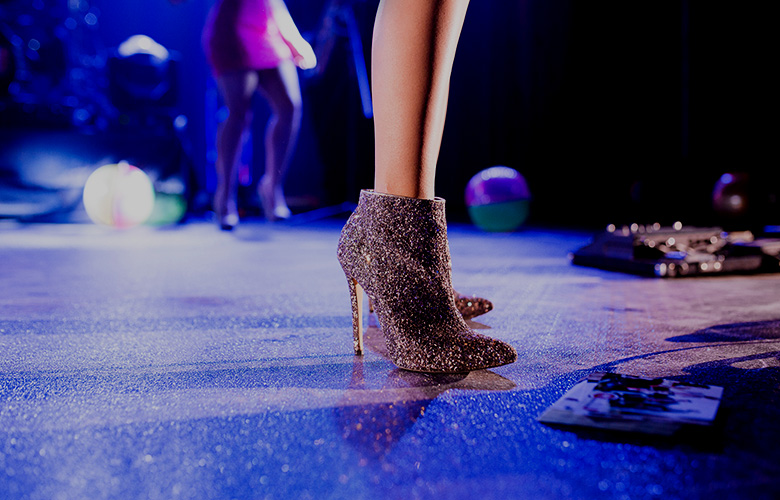
When you sign on as part of the ship’s crew on a cruise ship (even as a cruise ship dancer), there are lots of numbers you will have to remember. You’ll be given a crew ID number that you will need to quote when clocking in & out or recording your working hours on a timesheet. When you take part in safety drills on board the ship, you will no longer be known by your name but rather by your safety number. You will need to know which number liferaft or lifeboat you are assigned to in the event of an emergency and of course the first number you will want to learn will be your cabin number!
For some performers, however, you will have a whole other set of numbers to remember as well. Some of the productions on the larger cruise lines use a numbered system when it comes to spacing or blocking the routines in the shows. For those that have no idea what I’m talking about, let me explain…
For example, the numbers might start with zero at centre stage and increase as they travel out to stage left and stage right respectively. Whenever you are given a position in a routine, you are given a number – “Natalie, you start on number 1, stage right, then cross behind Sara to stage left, number 4” and so on. Every time you move positions within a routine, you are given your traffic (who you cross in front or behind) and also the number that you would move to.
To make things more complicated, you aren’t always given a whole number, sometimes you might be placed on 4.5 or even 3 & ¾! It’s not enough to just know the steps of the routine, you have to know each number that you have to get to within that routine and how you get there, so the lighting patterns correspond with your positions on stage. If you are dancing on number 4 but the lighting designer has programmed the lights to shine on number 3, well you may as well not be on stage because you’ll be dancing in the dark!
Back in my day (I’m not that old, really!), all of the spacing and traffic for the shows was recorded in a ‘blocking book’ which the dance captain would guard with their life during the contract. They would use this book when re-blocking the show, in the event a cast member was out due to injury, illness or vacation. These days, technology has, of course, advanced and there is software available that can be used on an iPad or tablet to help record all the blocking notes but back when I started, such a thing didn’t exist, so a blocking book was the only way.
Even though the dance captain has a record of all the blocking, it’s up to each individual dancer/singer to also record and learn their blocking.
During rehearsals, we would usually be given a few minutes after learning a routine to record our numbers for our own reference and we quickly learned to use this time wisely…
I can recall one early morning rehearsal, we were about to start working on a routine we had previously learnt, involving 5 female and 5 male dancers. The cast supervisor who was in charge of running rehearsals and teaching us the shows asked us to go to our first positions. With the blocking book in hand, he asked us each to tell him what number we should be standing on. He then asked us to travel to our next positions in that routine and again asked us what number we should be standing on.
As he went around the stage, we each told him which number we thought we should be standing on and he cross-checked it with the numbers in the blocking book.
When the final person gave him their number, our supervisor slammed the blocking book down on the stage with an almighty crash that echoed around the empty theatre. The next words out of his mouth were something to this effect “Out of the 10 of you, only 3 of you know which numbers you are meant to be on. I’m not going to waste my time if you’re not going to do the work. I’m not going to touch this routine now before opening night so you can clean this routine yourselves!” and with that, he stormed out of the theatre. We stood in stunned silence for a few minutes, awkwardly looking around the room, wondering if he was coming back, but when it was apparent that he wasn’t, our dance captain took charge and cleaned the routine, making sure we all reviewed our numbers first (for the record – I was one of the 3 that actually knew my numbers in the first place!).
The cast supervisor kept his promise and we opened the show without any further direction from him for that particular routine. He wouldn’t even give us notes for that routine during the tech and dress runs and if we had any questions, we didn’t dare ask him but instead directed them to our dance captain. Dancers rely on feedback to improve, so to not receive any further instruction or direction was a little difficult to deal with. We had no idea if what we were doing looked any good but we had to rely on the fact that the supervisor probably wouldn’t have let us go on if it didn’t…
Moral of the story – do your homework. If you are working on a stage with numbers, make it your duty to diligently record those numbers in whatever way works for you, be it on your iPad/tablet/phone or with just a trusty old pen and paper, it doesn’t matter the method as long as you record them accurately and learn them.
It’s easy enough to remember your spacing and traffic for one or two routines but when you start learning several routines a day, before you know it, you’ve learnt a whole show and are starting the next and you can’t remember what number you are supposed to start on, let alone finish! Unless you have a photographic memory, you are going to need something to refer back to. Our supervisor’s reaction may have seemed dramatic, but he was trying to teach us a valuable lesson.
The last thing you want is to be responsible for a collision or accident because you were dancing on the wrong number at the wrong time. Don’t be THAT person.
Also by Natalie Davids:
Surviving The Holiday Season At Sea
Rehearsals, Reputations and Ruffled Feathers, Part 1


Natalie Davids's training began at the age of 4 at her local dance school, now known as Stars Talent School (Sydney, Australia), where she trained in singing, acting and multiple styles of dance. She went on to complete full time training at Brent Street, graduating with a Certificate IV in Performing Arts. Natalie was fortunate enough to perform at the Opening Ceremony of the Sydney 2000 Olympic Games and the Closing Ceremony of the Sydney 2000 Paralympic Games before her career took her overseas and onto cruise ships. From 2001 - 2015, Natalie performed on board multiple cruise lines, most notably; Carnival Cruise Lines (dancer, lead dancer, magician's assistant), Fred Olsen Cruise Lines (inaugural cast member on the MS Balmoral, singer/dancer and dance captain) and Norwegian Cruise Lines (lead vocalist for Cover Stories Duo). In addition to her years at sea, Natalie has performed at high profile venues around the globe, including the Sydney Opera House, Window on China Theme Park (Taiwan) and Disneyland (USA). These days you can find Natalie performing in her homeland of Australia, for Aluminus Dance and Entertainment.
Read Full Profile© 2021 TheatreArtLife. All rights reserved.

Thank you so much for reading, but you have now reached your free article limit for this month.
Our contributors are currently writing more articles for you to enjoy.
To keep reading, all you have to do is become a subscriber and then you can read unlimited articles anytime.
Your investment will help us continue to ignite connections across the globe in live entertainment and build this community for industry professionals.